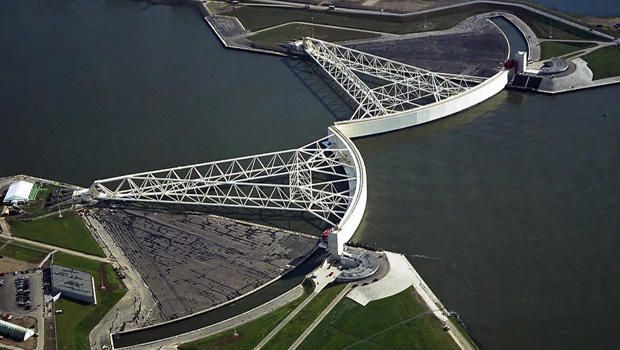How the Dutch Confront the Rise of the Oceans
Published on by Water Network Research, Official research team of The Water Network in Government
Windmills are more than just a traditional part of the Dutch landscape; they have played a key role in the war the Dutch have been waging against the ocean for the past thousand years.
By Martha Teichner

A massive storm surge barrier called the Maeslantkering, or Maeslant Barrier, was completed in 1997 to protect Rotterdam, Europe's largest port. CBS NEWS
The windmills at Kinderdijk were built nearly 300 years ago, to pump water out of the surrounding farmland. But the Dutch have been outsmarting the water that's everywhere around them for a thousand years,
It is a matter of survival. Twenty-six percent of the country is below sea level.
A massive storm surge barrier called the Maeslantkering, or Maeslant Barrier, was completed in 1997, to protect Rotterdam, Europe's largest port. It's equal in size to two Eiffel Towers, on their sides.
A massive storm surge barrier called the Maeslantkering, or Maeslant Barrier, was completed in 1997 to protect Rotterdam, Europe's largest port.
"This Maeslant Barrier is really here to safeguard us for the future," said Henk Ovink. He is water envoy for the King of the Netherlands -- a water ambassador, if you will.
The Dutch are the world's go-to water management experts. Ovink spent two years working in areas hit by Superstorm Sandy. "I said to them, 'Did you think of preventing the disaster?' And they were like, 'Preventing the disaster? No, we couldn't. No, we have to make sure that we respond faster.' And I said, 'But suppose that there is no disaster because you prepared better?'"
Who doesn't know the fable about the little Dutch boy who plugged the hole in a dike with his finger and saved his country?
What really happened taught the Netherlands about preparedness. A ferocious North Sea storm in January 1953 flooded 500 square miles and killed more than 1,800 people. The Dutch built themselves a fortress of flood protection.
Today, the Netherlands considers itself protected against a 10,000-year storm, in part thanks to research done by Deltares, a gee-whiz kind of place, with the largest wave machine in the world.
At their experimental facility, they can test structures that protect against the coast from ocean waves.
The largest wave machine in the world, at the Deltares engineering facility.
Deltares has worked with clients in 140 different countries, including the United States. Ap van Dongeren, a coastal flooding expert with Deltares, says all of their designs are assuming a rise in sea levels. "And that will come with higher waves, so you have to figure that all into your design," he said.
Sea levels in Holland are expected to rise more than three feet by the end of the century. This projection prompted the Dutch government -- so used to walling water out at all costs -- to rethink, and let the water in instead.
Read full blog: CBS News
Media
Taxonomy
- Disaster Prevention
- Marine
- Sustainable Water Resource Management
- Disaster Relief
- Water Management
- Infrastructure
- Dams
- Water Resource Management
- Infrastructure Management
- Flood damage
- Water Resources Management
- Sea Level Rise Risk Perception
- Sea Level Rise Vulnerability Assesment
- Marine Technologies
- Disaster Management
1 Comment
-
It is expected that the sea level in Holland will increase by more than three feet by the end of the century. This project prompted the Dutch government - so accustomed to pull water at any cost - to rethink and allow water instead. "
And by the end of the next century - all 30 feet.
It is necessary to stop climate change. Also it is offered as:
Climate change increases the frequency and intensity of droughts, floods and storms and increases sea level. All this is connected with water. "
Water, which has not been studied so far, has been created for billions of years. It is a living substance, the purpose of which is the transfer of substances to the conservation and development of biota. The way of its transformation in the circulation of water through the atmosphere, soil, biota. We interrupted this way. The increased volumes of artificial fumes closed the sky, changed atmospheric phenomena, led to natural disasters. All local actions to create a reduction in CO2 emissions, alternative energy sources, "green technologies", increased yield and diversification in the drier areas - all this flea fuss. Nature must return the taken away area, organic vapors. And to reduce artificial evaporation. Read more here: https://www.actascientific.com/ASAG/pdf/ASAG-02-0034.pdf. I offer cooperation in the proof of the Hypothesis.Ожидается, что уровень моря в Голландии возрастет более чем на три фута к концу века. Этот проект подсказывал голландскому правительству - так привыкшему стягивать воду любой ценой - переосмыслить и позволить воде вместо этого."
А к концу следующего века - на все 30 футов.
Необходимо остановить изменение климата. И предложено как:
Изменение климата увеличивает частоту и интенсивность засух, наводнений и штормов и повышает уровень моря. Все это связано с водой.»Вода, которая не изучена до сих пор, создавалась миллиарды лет. Это живая субстанция, назначение которой в переносе веществ сохранении и развитии биоты. Путь ее преобразования в кругообороте воды через атмосферу, почву, биоту. Мы прервали этот путь. Усиленные объемы искусственных испарений закрыли небо, изменили атмосферные явления, привели к стихийным бедствиям. Все локальные действия по созданию снижению эмиссии СО2, альтернативные источники энергии, «зеленые технологии», усиление урожая и диверсификация в более сухих районах - все это блошиная возня. Природе надо возвращать отнятые площади, органические испарений. И снижать искусственные испарения. Подробнее здесь: https://www.actascientific.com/ASAG/pdf/ASAG-02-0034.pdf. Предлагаю сотрудничество в доказательстве Гипотезы.